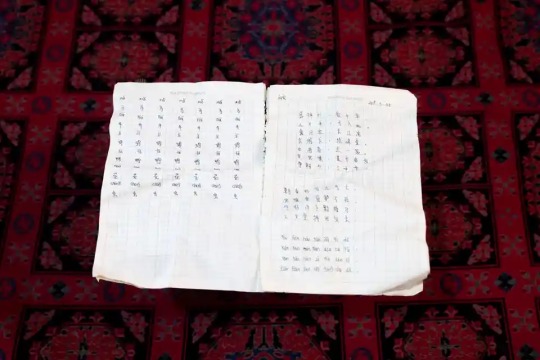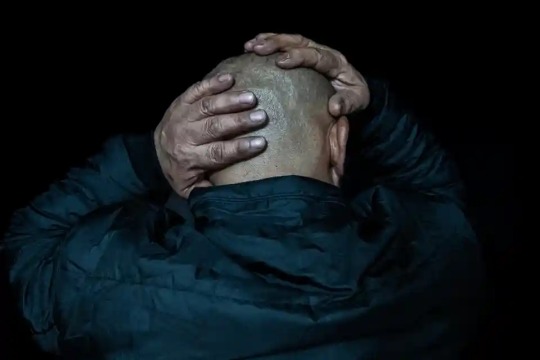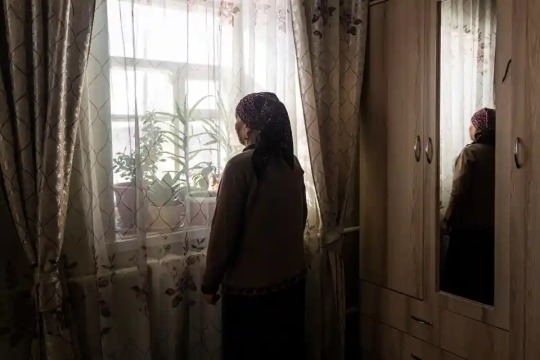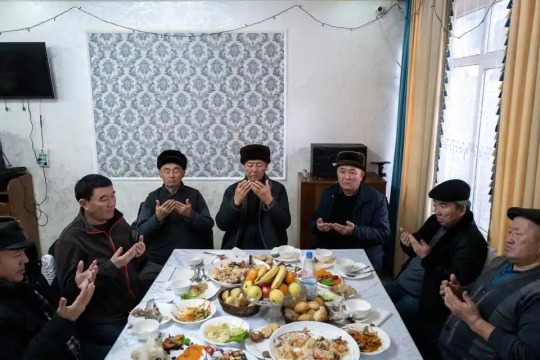blog with random stuff about kazakh/kazakhstani people. not an expert just want to share bits and pieces of my culture and experiences. everyone is welcome, except those who do not welcome others:).
Don't wanna be here? Send us removal request.
Text
Happy Nauryz!!
6 notes
·
View notes
Text
Since 2014, millions of Uyghurs, Kazakhs and other minorities have been locked up in China and subjected to torture and forced labour. Some of those freed talk about trying to rebuild their lives in neighbouring Kazakhstan.
Photography by Robin Tutenges

A Chinese course book
Saliman Yesbolat used to live in Ghulja county, Xinjiang. After she refused to denounce her Uyghur neighbours to the police, she was forced to perform the raising of the Chinese flag every Monday at dawn, and to attend Chinese lessons twice a week in the basement of her building, where she would learn the Chinese language, patriotic songs and Xi Jinping's discourses by heart. This is her exercise book.

Forced to leave China
At 65, Imam Madi Toleukhan is one of the oldest refugees in Bekbolat, Kazakhstan, where more than 100 families took shelter after fleeing the Chinese regime. 'We were richer back there. I owned a herd, but I was too afraid for my sons, my grandchildren and their future: I came to Kazakhstan to save them. I didn't want them to be the fourth generation to suffer at the hands of the Chinese government, he says.

Remembering Uyghur culture in exile
Two members of the Dolan Ensemble, a Uyghur dance troupe based in Kazakhstan, get ready before performing a traditional dance to mark 40 days since the birth of a baby. Founded in 2016, the troupe performs at festivals or private events that bring together members of the Uyghur community, some of whom have had to leave Xinjiang.

Torture, infertility and damaged genitalia
In Kazakhstan, medical care for camp survivors is poor. Most victims can barely afford to see a family doctor. Anara*, an endocrinologist in a Kazakh hospital who has examined about 50 camp survivors since 2020, noticed recurrent infertility problems among her patients. 'Men or women, many have damaged genitalia. Some told me they'd been given drugs, others said they'd been raped. As they didn't come to us right after being released from the camps, it's impossible to know what kind of drugs they were administered in Xinjiang, she says. *Not her real name

The tiger chair
Ospan* spent a year in a re-education camp. He says his mind and body were crushed by the tortures he experienced in a tiger chair - a steel apparatus with handcuffs that restrains the body in painful positions. Aged about 50, this former shepherd, who took refuge with his family in eastern Kazakhstan, is no longer fit for work. Physically wrecked and prone to headaches, he mourns the loss of his memory above all. 'I used to know a lot of songs and I loved to sing; I also knew poems by heart ... Now, I can't sing any more, I can't remember the words,' he says. *Not his real name

Broken families and imprisonment
Aikamal Rashibek saw the dreadful efficiency of the CCP's brainwashing on her husband, Kerimbek Bakytali, after he was released from a Chinese psychiatric hospital. 'He disappeared for a year. When he came back, he didn't tell me anything about what happened to him. He was highly unhinged, always nervous, and got angry whenever I asked questions. He couldn't stop repeating that he hated Kazakhstan now, and that he wanted to go back to China with the kids to give them a Chinese education, says Aikamal. They are now separated.

Missing loved ones in China’s camps
In March 2017, Miyessar Muhedamu, left, a Uyghur woman, was arrested in Xinjiang under the pretext that she had studied Arabic in Egypt when she was young. Her husband, Sadirzhan Ayupov, right, and her three children have not seen her since. Now that Miyessar has left the camp, Sadirzhan receives a short call every few months. He suspects she might have suffered abuse, yet Miyessar can’t speak freely. ‘She told me she’d been in a re-education camp, and that she’d been released. When I ask her what she went through there, she doesn’t answer,’ says Sadirzhan.

Life after fleeing China
Sent to a re-education camp in 2018 at the age of 64, Yerke* saw her health quickly deteriorate. Locked a tiny cell with dozens of other women, she almost lost the use of her legs due to the cold floor she had to lie on. She was in the camp when she learned of her son’s death: pressured by the Chinese authorities, he took his own life. After her release, Yerke fled to Kazakhstan with some family members, but two of her children remain in China. *Not her real name

Forced labour and confessions
Dina Nurdybay, 32, was arrested in Nilka county, Xinjiang, because her traditional Kazakh clothing business made her a separatist, according to the Chinese authorities. She spent 11 months between two re-education camps, a CCP school and a forced-labour sewing factory. After proving she was capable of being ‘well behaved’ and having performed a self-criticism in front of the whole village, Dina was released and managed to escape when she obtained a week’s leave to visit her ailing father in Kazakhstan.

Cultural genocide
China’s repression of ethnic minorities also involves cultural genocide. As Muslim rituals are forbidden in Xinjiang, people are trying to keep their traditions alive across borders. Here, a family is praying together in Kazakhstan after the death of one of their relatives in Xinjiang. They could not repatriate the body because the border between the two countries was closed at the time.
(continue reading)
476 notes
·
View notes
Text
"In a historic step toward the first-ever restoration of the tiger population to a nation where they were once extinct, two captive Siberian tigers have been translocated from Anna Paulowna Sanctuary, Netherlands, to the Ile-Balkhash Nature Reserve in Kazakhstan.
This remarkable event is part of an ambitious program led by the Government of Kazakhstan with support from WWF and the UN Development Program to restore the Ile-Balkhash delta ecosystem and reintroduce tigers to the country and region, where the species has been extinct for over 70 years.
“It is a high priority for Kazakhstan to work on the restoration of rare species. For ecological value it is important that our biodiversity chain is restored. And that the tiger that once lived in this area is reintroduced here,” said Daniyar Turgambayev, Vice-minister of the Ministry of Ecology and Natural Resources of Kazakhstan.
In the early 21st century, genetic studies were carried out on bones and furs held in national collections which revealed that the population of tigers living between Iran, southern Russia, Central Asia, and the areas around the Caspian Sea was extremely similar to Siberian tigers.
This led scientists to conclude that Felis vigrata, the former name of the Caspian tiger, was simply the Siberian tiger that developed into a distinct population, but not a new subspecies, over generations of being separated by habitat fragmentation.
Bodhana and Kuma, the male and female tigers, will be housed in a spacious semi-natural enclosure of three hectares [7.4 acres] within the Ile-Balkhash Nature Reserve. Any of their offspring will be released into the wild and will become the first tigers to roam Kazakhstan in decades, and potentially the first-ever international tiger reintroduction.
They will play an important role in the establishment of a new tiger population in the region where they had previously been wiped out as a result of excessive hunting.
“Today marks a monumental conservation milestone to bring tigers back to Kazakhstan and Central Asia,” said Stuart Chapman Leader of WWF Tigers Alive. “This tiger translocation is a critical step to not only bring back the big cat to its historic homeland but also to rewild an entire ecosystem.”
Progress towards restoration of the area is already well underway with recovering and reintroduction of critical tiger prey species like the Kulan (Asiatic wild ass), and reforestation of over 120 acres with native trees. Being the apex predator, tigers will play a significant role in sustaining the structure and function of the ecosystem on which both humans and wildlife rely...
“With the launch of the tiger reintroduction program, we have witnessed a significant change—the revival of nature and our village of Karoi,” said Adilbaev Zhasar, the head of the local community group Auyldastar.
“This project not only restores lost ecosystems, but also fills us with pride in participating in a historic process. Because of small grants from WWF, we have the opportunity to do what we love, develop small businesses, and create jobs in the village, which brings joy and confidence in the future.”
From the very beginning, the local community around Ile-Balkhash Nature Reserve has been closely involved in the project. This includes support for improved agricultural techniques and the future development of nature tourism in the area.
The translocation of these tigers is the first of several planned in the coming years, with a goal to build a healthy population of about 50 wild tigers by 2035, starting with this pioneering pair for breeding. This initiative is not only a testament to the resilience of the species but also a powerful example of governments, conservation organizations, and local communities cooperating in wildlife and nature conservation."
-via Good News Network, November 27, 2024
2K notes
·
View notes
Text

chalk mountains in üstirt, qazaq caspian steppe
#i have been there!#maybe not exactly at this point#but yeah it is reaally cool#and much bigger than you think#also valley of balls there#kazakhstan#kazakhstan nature
46 notes
·
View notes
Text
One of the easiest ways you can remember the date when the capital of Kazakhstan was moved from Almaty from Astana is to remember that Bäiterek

is exactly 97 meters tall, which corresponds to the year 1997 when the said event happened.
Also, inside the golden egg on the top you can find a golden plate with a deep imprint of Nursultan Nazarbayev's hand. You can put your hand there.
14 notes
·
View notes
Text

Reading about the Przewalski's horse returning to the steppes of Kazakhstan and drawing about it.
299 notes
·
View notes
Text
One of the more interesting things that happened as a direct result of Russification, is the term "shala" kazakh.
A "shala" kazakh is a person who lived their entire lives in Kazakhstan, is Kazakh, but does not know the language.
This is not a new thing obviously, the term has a history going back before Kazakhstan's independence, but it is one of the facets of the whole "Hey perhaps we should bring more focus to Kazakh language" discussion.
If anybody curious the main reason behind this, is the fact that schools in Russian were generally regarded as more prestigious, and in general, USSR closed a lot of schools in Kazakh, leaving only one Kazakh school per major town.
39 notes
·
View notes
Note
Hello! Do you have any information about regional differences in Kazakh clothing, or differences in Kazakh clothing between the three jüz? For example, are there any features that are unique to shapan from southern Kazakhstan, or that are only found on the shapan of Kazakhs from the Uly jüz? Thank you for your blog! I love it!
Hello!
Sadly I do not know much about regional differences in clothing. In general it is not something that was recorded as thoroughly, as some other aspects of traditional lifestyle. Also, after the colonization, a mass production of clothing and fabric, and general Westernisation of Kazakhstan, clothes, even traditional ones become somewhat more monogamous.
However there is a nice article from caravan.kz that points to a few sources.
First of all this lovely line up from Qańtars on the instagram, where you can also find a more in-depth explanation:
instagram
Another source are illustrations created by Aisha Galimbaeva, the first official kazakh female artist.
There aren't a lot of them, but they are still a bit much for a tumblr post, and the descriptions are not translated so for your convenience I dropped them as an archive in google drive, with translations as titles.
Also! In the modern times you would probably see Southern and Western women wear a little bit longer skirts, with their traditional clothing because, yk. conservative values.
28 notes
·
View notes
Note
hi! what qazaq names do you like and why?
That's a good question honestly.
I think Azamat is quite interesting. Literally, it means citizen, but mostly it reminds me of the movie created by the artist group called Irina Kairatovna dedicated to Kazakhstan's independence reaching it's 30 year mark. The protagonist was born on December 16th of 1991, the day of Kazakhstan's independence, which is the reason behind the name. A new child, a new citizen of a new country.
For a girl name... I think Meruert is beautiful. It means pearl, but I also like the way it flows on the tongue. All girl names in Kazakh are quite nice. There are Alma and Anar, which mean Apple and Pomegranate respectively. Gauhar has an interesting h to it, and means a diamond. There is also Dana, which means wise.
In general though, I think the coolest names are compound names. Not just a flower, but a golden flower "Altyngül".
Arystan, "lion", also rocks. Has a nice ring to it.
10 notes
·
View notes
Note
Hi! I have followed you for a while and I'm so glad you chose to make this blog and share about your culture. You share so many details that would be difficult to learn about outside of first person experience, especially with the lack of resources about Kazakhstan and Kazakh culture in English.
I am especially grateful for this right now. I have an assignment for a class where I need to right 1000 words about a country I want to go to, and specifically about the deep culture (people’s attitudes, beliefs, and core values, including attitudes towards gender, social status, age, raising children, perception of time, the role of family) and classroom and educational culture.
I am going to dig through your blog and some other Kazakhstan focused blogs on here as one part of my research, and I hope you're okay with me citing you as a source! Additionally, if there's anything more you would like to share about these topics that you think I should include, I would be super grateful for your contribution! It's not a super academically rigorous assignment, but I want to represent Kazakh & Kazakhstani culture well.
Appreciate you so much, hope you have a wonderful day!
Oh wow!!
This is! Unexpected I would say!
First of all I would like to say thank you. Sharing information about my country's culture and history that would usually be unreachable in English was part of the reason why I made this blog, and I am thankful that it inspired so much interest from you.
Also sorry. I might be a bit late to join into your assignment. But, I think one of the main topics I don't usually share about on this blog is the modern state of Kazakhstan as a political space? That's mostly because it is so hard to describe.
Today's Kazakhstan is like waves in the sea. Constantly changing, no direction and always in the same one at once.
Outside mainstream media tends to mainly ignore Kazakhstan in favour of reporting on our more active neighbours, but when it does report it is mainly news like the Bloody January or the continuous autocracy of our government.
But inside it is just a life you know? There is a rise of religious schooling in the south, and the rates of domestic violence don't seem to change, but there are more people disgusted by it, and tenge is always falling.
The thing is, Kazakhstan is in a point in it's history where something will inevitably happen. It is undeniable by just looking at history's own old and recent examples. Which is why it is so hard to describe how Kazakhstan seems to be going both forward and backwards, Westernizing and holding onto Soviet values and Traditional values at the same time, youth becoming more open-minded but also kore religious.
It is a mess.
#again sorry! for being late#personal#kazakhstan#kazakh#the problem with the fucking child suicide rates is that I know they are fucking falsefied at least#to some degree#but what about the differential?? who knows
5 notes
·
View notes
Note
Hello! Do you have any information about regional differences in Kazakh clothing, or differences in Kazakh clothing between the three jüz? For example, are there any features that are unique to shapan from southern Kazakhstan, or that are only found on the shapan of Kazakhs from the Uly jüz? Thank you for your blog! I love it!
Hello!
Sadly I do not know much about regional differences in clothing. In general it is not something that was recorded as thoroughly, as some other aspects of traditional lifestyle. Also, after the colonization, a mass production of clothing and fabric, and general Westernisation of Kazakhstan, clothes, even traditional ones become somewhat more monogamous.
However there is a nice article from caravan.kz that points to a few sources.
First of all this lovely line up from Qańtars on the instagram, where you can also find a more in-depth explanation:
instagram
Another source are illustrations created by Aisha Galimbaeva, the first official kazakh female artist.
There aren't a lot of them, but they are still a bit much for a tumblr post, and the descriptions are not translated so for your convenience I dropped them as an archive in google drive, with translations as titles.
Also! In the modern times you would probably see Southern and Western women wear a little bit longer skirts, with their traditional clothing because, yk. conservative values.
#kazakh clothing#kazakh#kazakhstan#kazakh tradition#kazakh culture#also sorry for not answering for so long? i think my askbox glitched out#hope this helps btw it was very fun to look at at least#and i might make another post for clothing but with just excerpts from encyclopedia or smth#idk how it will turn out
28 notes
·
View notes
Note
happy көрісу 😊
Happy Körısu to everyone and to you too anon!! Visit your family, and friends celebrate the coming of spring!!!
Nesıbe mol bolsyn!
3 notes
·
View notes
Text
hi guys
this account will probably be a non-serious one that displays the beauty of the city of almaty and kazakhstan in general, as I'm an almaty native
posts are probably going to be infrequent, but as I'm expecting maybe at most >100 followers, it doesn't really matter
big thanks to @random-kazakh-stuff for inspiring this account, we need more kazakh representation
anyways, Алматы қаласы ең жақсы қаласы🦅🦅🦅🦅🦅🦅
19 notes
·
View notes
Text
This February was the longest in history of Kazakhstan, because not only it was a leap year, but we also switched timezones in the East, which means this February was 29 days and an hour.
19 notes
·
View notes
Note
what are your favorite kazakh traditions? any events you look forward to every year?
Probably Körısu which is on 14th of March.
It is a celebration of the start of spring only in Western Kazakhstan, which you do by just going around your family(extended) and acquaintances and greeting them and just being happy about the start of the spring.
I do not exactly know why there is Körısu AND Nauryz, but it could be because Western Kazakhstan has a much softer climate compared to Northern or Western Kazakhstan. Could also be because of influences from other nations centuries ago. Or something different.
Also Körısu was kinda about visiting other auyls(nomadic settlements), to check on how they weathered through the winter.
It is not an official holiday, but it is just a nice thing only my region has.
My other favourite tradition probably comes from a saying "нағыз қазақ - қазақ емес, нағыз қазақ - домбыра" which translates to literally "a real kazakh is not a kazakh, a real kazakh is dombra" which implies that all real Kazakhs know how to play on dombra. I am not sure if it has historical grounds, but that love for dombra and a desire to secure the future of the art, led to an entire set of schools having free dombra lessons.
#dombra is such a lovely instrument and I have never appreciated for#HOW HARD IT IS OH MY GOD#it also sounds completely different in real life than in recordings#kazakh#kazakhstan#kazakh culture#how hard can an instrument with 2 strings be?#the answer is extremely
15 notes
·
View notes
Text
The official day of Love in Kazakhstan is not on February 14th. February 14th is the Saint Valentine's day, and while being celebrated internationally has Western roots which for our government was enough to denounce it a few years back.
What's the official Love day in Kazakhstan then?
It's 15th of April and is dedicated to the story of Qozy-Körpeş and Baian Sūlu.
Will tell you their story then.
#kazakh#kazakh history#kazakh culture#kazakhstan#happy valentine's day#for all those who celebrate though
18 notes
·
View notes